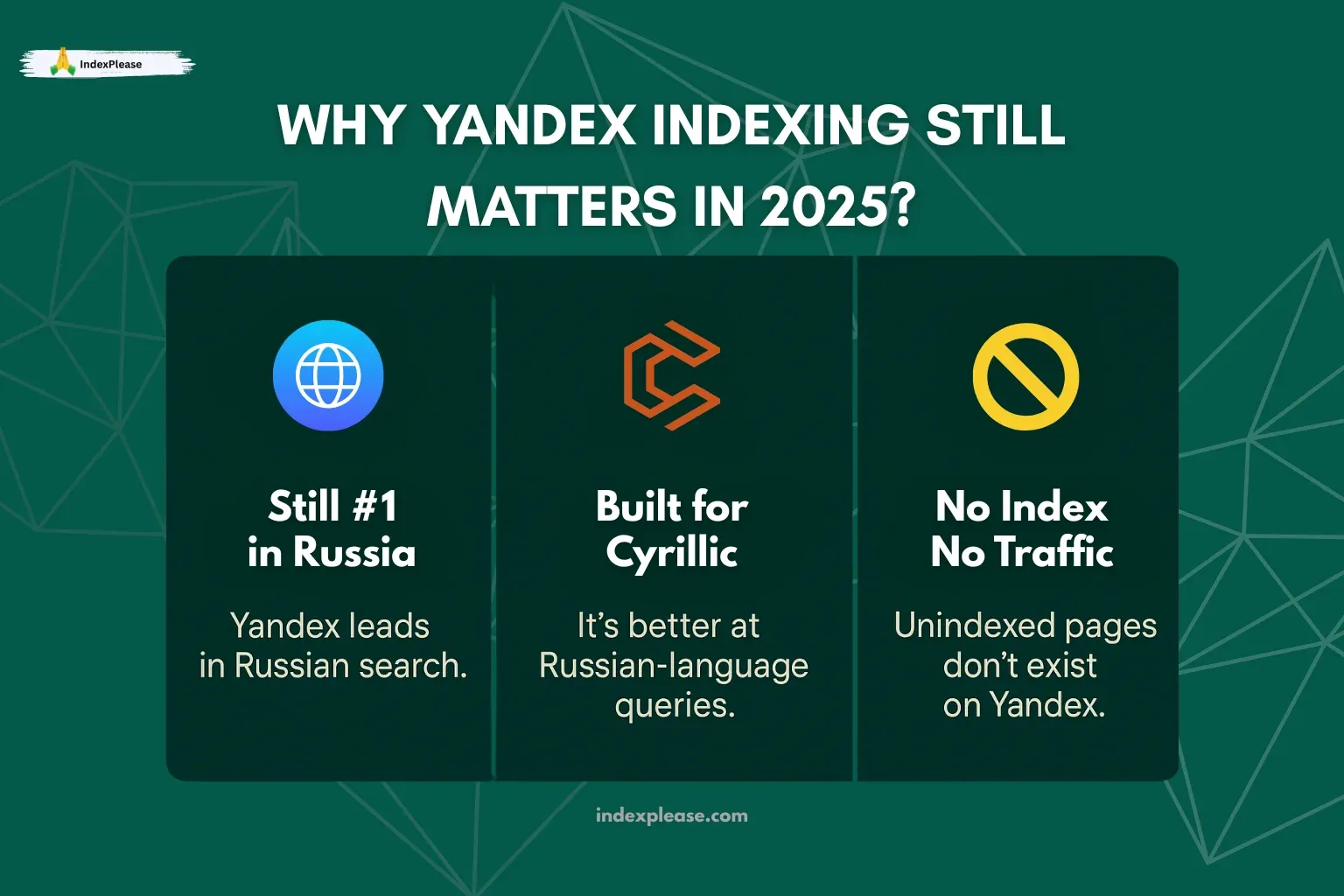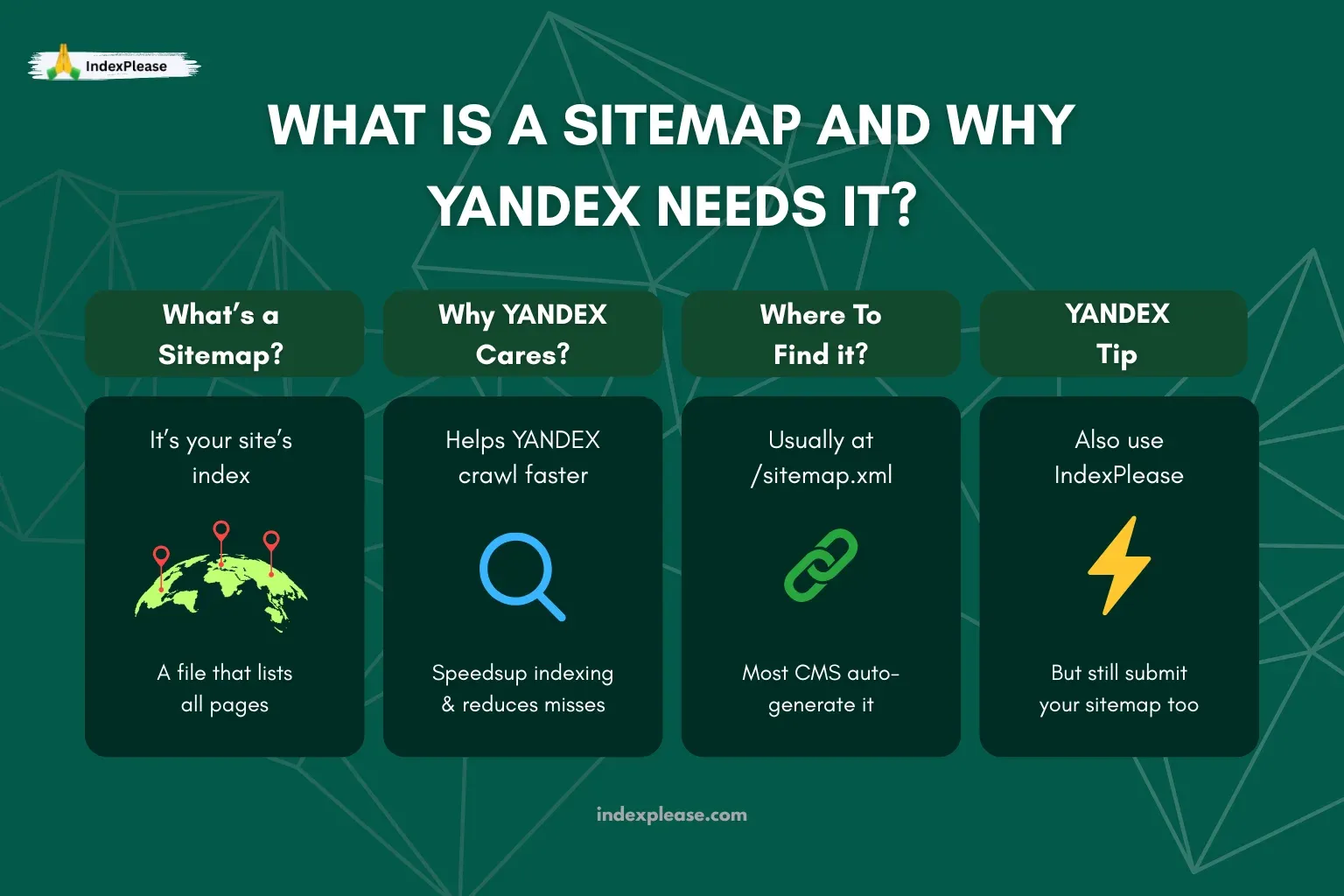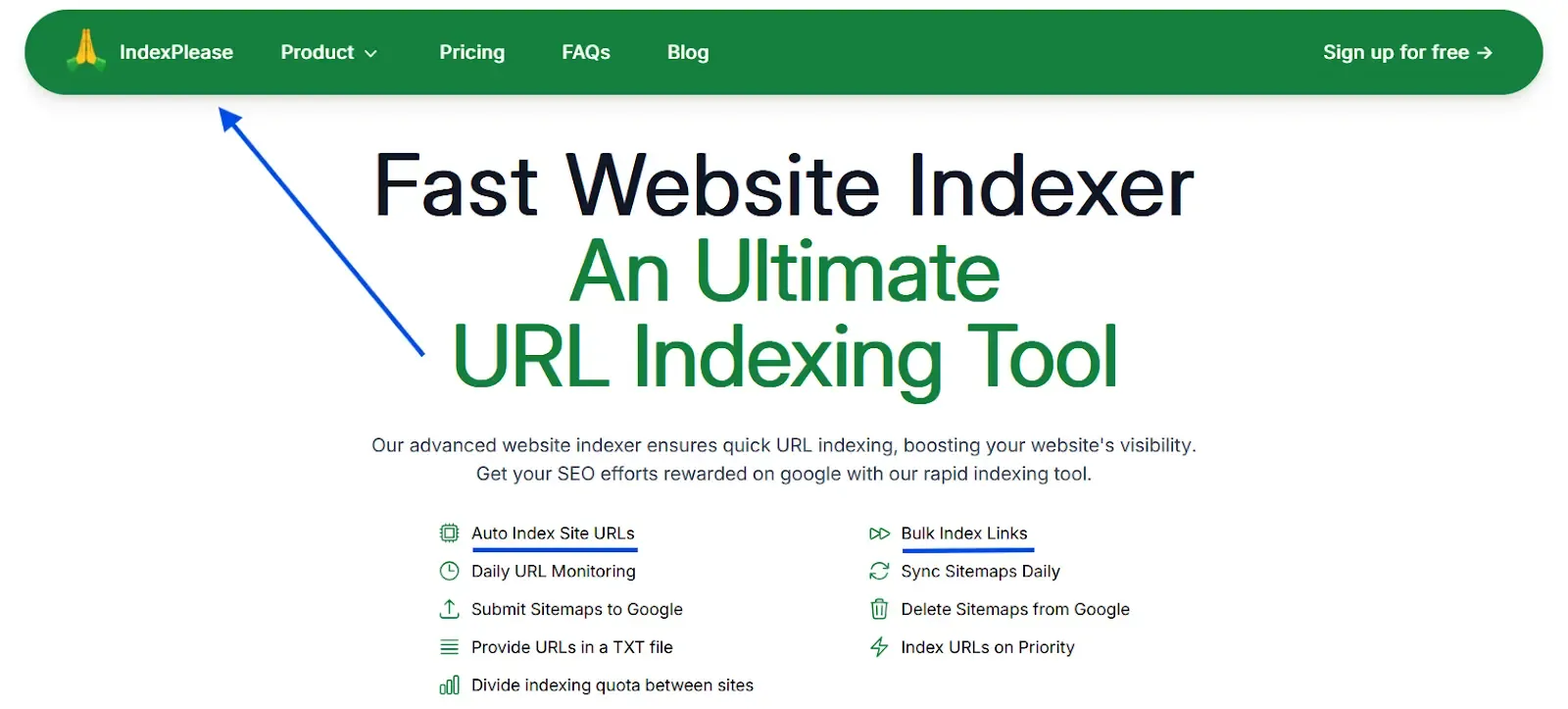
How to submit your sitemap to Yandex
If you’re targeting Russian-speaking users or expanding into Eastern European markets, you’ve probably heard of Yandex, Russia’s dominant search engine. But here’s what many SEOs still miss: Getting indexed on Yandex is not the same as getting indexed on Google.
YandexBot behaves differently. Its rules are stricter. And unless your pages pass multiple layers of review, they may never make it into the index.
Yandex quietly maintains a firm grip on nearly half of Russia’s search market. According to Statcounter’s 2025 report, Yandex holds between 40% to 50% of the local search share, with millions of daily users browsing via Yandex Search, Yandex Mail and the Yandex app ecosystem.
This matters even more today because Yandex’s AI-powered search layer, known as YandexGPT Overviews, is changing how users find answers. Just like Google’s AI Overviews, Yandex now pulls its quick-answer snippets and featured content from a very small pool of trusted, high-authority, well-indexed sites. If your site isn’t part of that trusted pool, you’re invisible.
And here’s the catch: If you’re running your site on WordPress, Shopify or Ghost, you’re already at a disadvantage. Most Western CMS platforms aren’t built with YandexBot in mind. This means your new blog posts, product pages or landing pages could sit in a “Discovered but not indexed” status for weeks or never get indexed at all.
Why Yandex Indexing Still Matters

In an SEO world ruled by Google, it’s easy to overlook Yandex. But if you’re targeting Russian-speaking audiences, ignoring it means leaving clicks and conversions on the table.
The Reach of Yandex in 2025
- Yandex still holds the top search engine share in Russia
- Popular in Belarus, Kazakhstan, Uzbekistan and other Cyrillic-first countries
- It powers localized results, Yandex Maps, News, Market and Ads
- Preferred by users for Russian-language queries due to contextual understanding and Cyrillic optimization
What Makes Yandex Different (and Valuable)
- Yandex ranks Russian-language content more effectively than Google
- It prioritizes local services, domains and metadata tied to the .ru ecosystem
- It heavily surfaces its own ecosystem features, like shopping, Q&A, news, much like Naver in Korea
You Can’t Rank Without Getting Indexed
You might have the best Russian landing page, product description or article but if Yandex doesn’t crawl and index it, it simply doesn’t exist to your audience. That’s why this process, while technical and slower than Google, is so critical.
What Is a Sitemap and Why Seznam Needs It

If search engines are like librarians, your sitemap is the index card that tells them what’s on the shelf. It’s a structured file, usually in XML format, that lists all the important pages on your website. Think of it as a roadmap for your site, built specifically for search bots.
What Does a Sitemap Look Like?
It’s usually a file located at: https://yourdomain.com/sitemap.xml
Modern SEO platforms like WordPress (with Rank Math or Yoast), Ghost and Shopify all auto-generate this file for you.
If you’re using WordPress, your sitemap is likely at: https://yourdomain.com/sitemap_index.xml
Why Yandex Pays Attention to Sitemaps
Yandex has its own crawler called YandexBot. It works differently from Googlebot. While Google is great at discovering new pages on its own, YandexBot is more conservative, it waits for you to tell it what’s important.
Submitting your sitemap to Yandex helps with:
- Faster discovery of new pages and blog posts
- Better understanding of your site structure
- Prioritizing important content you want to rank
- Reducing missed or orphaned pages that don’t have internal links
If you’re publishing content in Russian or targeting countries like Russia, Kazakhstan or Belarus, you can’t afford to skip this step. Without a sitemap, your site might take weeks to fully show up in Yandex’s index, if it shows up at all.
How to Use Yandex Webmaster

If Google has Search Console, Yandex has Webmaster Tools and it’s the only reliable way to monitor and control indexing on Yandex in 2025.
Here’s how to make the most of it:
Step 1: Set Up and Verify Your Site
- Go to https://webmaster.yandex.com
- Sign in with a Yandex account
- Add your domain
- Verify using:
- HTML file upload
- Meta tag
- DNS record (recommended for root domain control)
Step 2: Submit Your Sitemap
- Submit your XML sitemap via the “Indexing → Sitemap Files” section
- Make sure your sitemap:
- Is UTF-8 encoded
- Includes only canonical, crawlable URLs
- Excludes 404s, redirects and
noindexpages
Yandex doesn’t crawl sitemaps often, so update yours regularly and re-submit manually if needed.
Step 3: Monitor Crawl Activity
In the “Indexing → Crawl Statistics” section, track:
- Number of pages crawled per day
- Response codes (200s, 404s, etc.)
- Crawl errors by category
You’ll also see if YandexBot is encountering blocked resources, duplicate content or encoding issues.
Step 4: Diagnose Indexing Issues
- Visit the “Excluded Pages” tab, this is where most missed pages live
- Common reasons:
- Duplicate content
- Blocked by robots.txt
- Low-quality or thin content
- Redirected or canonicalized to another page
Step 5: Use the HTML Validator
Yandex.Webmaster offers diagnostics tools to spot:
- Invalid HTML structure
- Missing titles/descriptions
- Charset issues (especially with Cyrillic)
Fixing these can improve crawl and indexing priority.
Step-by-Step: How to Submit Your Sitemap to Yandex
Submitting your sitemap to Yandex is easier than most people expect. You don’t need to be a developer and you won’t be editing code. All you need is your website, a Yandex account and your sitemap link (usually auto-generated by your CMS).
Here’s how to do it:
Step 1: Create or Log in to Your Yandex Account
Go to https://passport.yandex.com and sign up or log in. You’ll use this account to access Yandex Webmaster Tools.
Choose a business or admin email address if you’re managing a brand or client site.
Step 2: Open Yandex Webmaster Tools
Visit https://webmaster.yandex.com and click “Add site.” Enter your full domain name (e.g., https://yourdomain.com) and click continue.
Step 3: Verify Your Website
To prove that you own the site, Yandex will offer you 3 options:
- Meta Tag – Copy the tag and paste it into your website’s
<head>section. - HTML File Upload – Upload a provided file to your root directory.
- DNS Record – Add a TXT record in your domain registrar’s settings.
Once done, click “Check” to confirm verification.
You’ll see a success message once your site is verified.
Step 4: Find the Sitemap Tab
Inside your site’s dashboard in Yandex Webmaster, go to the “Indexing” menu on the left and click “Sitemap files.”
Step 5: Submit Your Sitemap
Enter the full URL of your sitemap , usually something like:
https://yourdomain.com/sitemap.xml
Click “Add” or “Submit.”
If your CMS is WordPress, Ghost or Shopify , your sitemap is probably auto-generated.
Step 6: Monitor Your Sitemap Status
After submission, Yandex will start processing your sitemap. You’ll be able to see:
- How many pages were found
- How many were indexed
- Any crawl errors or warnings
Check back over the next few days for updates , indexing can take a little time.
Common Indexing Issues with Yandex
Even if your content is visible on Google, Yandex might ignore it, especially if you don’t follow its strict technical preferences. Here are the most frequent blockers:
1. Duplicate Pages from UTM or Tracking Parameters
Yandex treats every unique URL as a separate page, including ones with ?utm_source= or other query strings.
Fix:
- Use canonical tags properly
- Exclude tracking parameters in sitemaps
- Block junk URLs via
robots.txtwhere safe
2. Slow Crawls Due to Sitemap Structure
A bloated or outdated sitemap will slow down indexing, Yandex may crawl irrelevant URLs and miss your fresh content.
Fix:
- Keep sitemap under 50,000 URLs per file
- Submit only index-worthy pages
- Update frequently and resubmit in Yandex.Webmaster
3. JavaScript-Only Rendering
YandexBot doesn’t process JavaScript the way Google does. If your content is loaded dynamically, Yandex might see a blank page.
Fix:
- Use server-side rendering or pre-rendering for JS-heavy sites
- Include crawlable fallback HTML where possible
4. Misconfigured host: or robots.txt Settings
Yandex depends heavily on the host: directive to determine your main domain. Wrong setup = crawl confusion.
Fix: In your robots.txt, specify:
Host: www.example.ru
and avoid over-restrictive Disallow: rules.
5. Meta Charset or Cyrillic Encoding Issues
Pages without proper UTF-8 encoding or missing meta charset declarations may be skipped or misread.
Fix: Ensure all pages declare:
<meta charset="UTF-8">
And all titles/meta content use valid Cyrillic if targeting Russian-language keywords.
These issues often go undetected, unless you’re actively monitoring crawl logs or using Yandex.Webmaster.
Automate Faster Indexing with Indexnow + Indexplease

Let’s be real, waiting days or even weeks for Yandex to crawl your new pages is frustrating. Luckily, there’s a faster way to get Yandex’s attention, without having to manually submit URLs every time you hit “publish.”
It’s called IndexNow and Yandex fully supports it.
What Is IndexNow?
IndexNow is a free, open indexing protocol supported by search engines like:
Here’s how it works:
Every time you publish, update or delete a page. You send a small notification (called a ping) to Yandex.
The ping tells Yandex:
Hey, I’ve got fresh content. Please crawl this specific URL now.
This means no more waiting around for YandexBot to stumble upon your site on its own.
How indexplease Automates It for You
Setting up IndexNow manually means dealing with API keys, JSON files and server settings, not fun for non-developers.
That’s why tools like indexplease exist.
Here’s what indexplease does:
- Auto Index Site URLs
- Daily URL Monitoring
- Submit Sitemaps to Google
- Provide URLs in a TXT file
- Divide indexing quota between sites
- Bulk Index Links
- Sync Sitemaps Daily
- Delete Sitemaps from Google
- Index URLs on Priority
Your WordPress or Shopify site stays in Yandex’s crawl queue, without you lifting a finger.
Final Thoughts:
If you’re serious about reaching Russian-speaking audiences, getting your site indexed on Yandex isn’t a side quest , it’s the mission-critical first step.
With its unique ecosystem, conservative crawler and growing reliance on AI-driven features like YandexGPT Overviews, Yandex operates on an entirely different playbook from Google. That means you can’t just wait for bots to “figure it out.” You need a strategy.
IndexPlease isn’t just a convenience tool , it’s how smart SEO teams stay visible across global search engines. With automated pinging, bulk submission and smart retry logic, it ensures your content doesn’t get lost in crawl purgatory.
FAQs
1. How long does it take for Yandex to index my site after I submit the sitemap?
It can take anywhere from a few hours to several days. YandexBot is slower than Googlebot and may crawl based on site authority, crawl budget and whether IndexNow pings are received. To speed it up, use IndexPlease to automate pings via IndexNow.
2. Do I need to submit my sitemap more than once?
Yes , especially if you’re publishing new content regularly. While Yandex eventually recrawls, manual re-submission or an automated solution like IndexPlease can drastically reduce waiting time.
3. Does Yandex support robots.txt and noindex directives like Google?
Absolutely. Yandex respects standard SEO directives like robots.txt, noindex, canonical tags and meta directives. But be careful: over-restrictive robots.txt files are a common reason for missing pages in Yandex.
4. Can I use Google Search Console sitemap tools for Yandex too?
No. Google and Yandex are entirely separate systems. You must set up your site in Yandex.Webmaster and submit your sitemap directly there.
5. What is IndexNow and how does it help with Yandex indexing?
IndexNow is a ping-based protocol that notifies search engines like Yandex, Bing and Naver when content is added or changed. This reduces crawl latency. Platforms like IndexPlease integrate IndexNow automatically , no manual pinging needed.
6. Can I track indexed pages in Yandex the way I do in Google?
Yandex.Webmaster offers tools for checking crawl stats, excluded pages and indexing progress. It’s not as advanced as Search Console, but it gives clear diagnostics if a page is blocked, redirected or skipped due to content quality.
7. Does Yandex support non-Cyrillic websites?
Yes , but it favors content written in Russian and hosted on regional domains like .ru or .by. If you’re targeting Russian speakers, make sure your metadata, headings and language attributes are properly localized.